


CRATERS OF THE MOON NATIONAL MONUMENT
Unless otherwise noted, photos (c) Helen Thayer
The lava field of Craters of the Moon spreads across 1,100 square miles; it is the largest mostly basaltic lava field in the contiguous United States. The Monument and Preserve contain more than 25 volcanic cones, including outstanding examples of spatter cones. The 60 distinct solidified lava flows that form the Craters of the Moon lava field range in age from 15,000 to just 2,000 years.
Helen Describes Her Visit to Craters of the Moon [Page One]
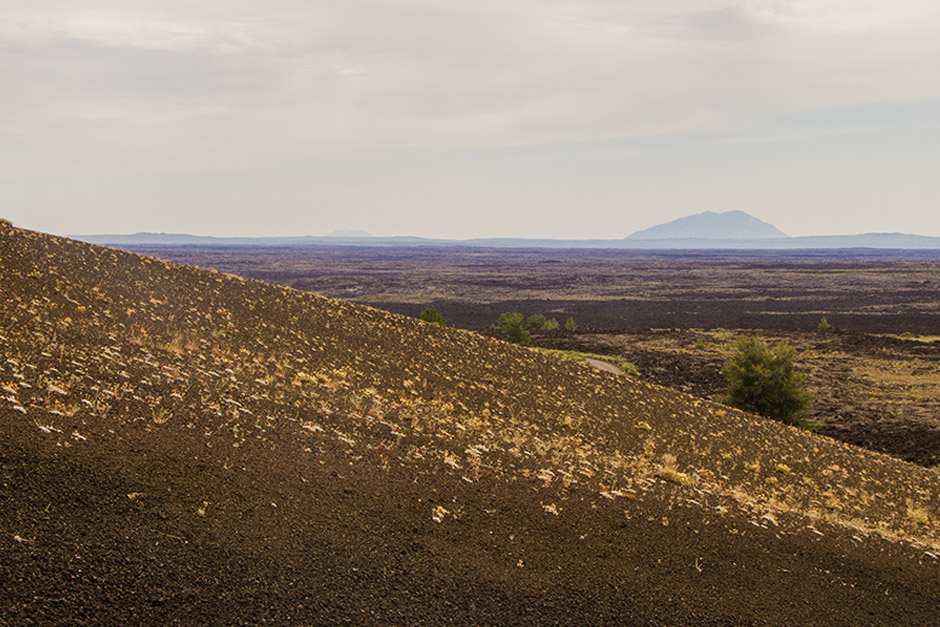
The vastness of the area
The immense volume of lava that covers the Craters of the Moon did not result from one volcano, but instead issued from a series of deep fissures known collectively as the Great Rift which stretches over 50 miles across the Snake River Plain. Magma is composed of molten rock and is stored in the Earth's crust. Lava is magma that reaches the surface of our planet through volcano vents and fissures. Magma under pressure can follow these cracks and fissures to the surface. 15,000 years ago lava welled from the Great Rift to produce the enormous ocean of lava that spread before the visitor today. The last eruptions are believed to have occurred 2,000 years ago. Scientists believe that more eruptions will occur within the next 1,000 years. Geologists believe that Craters of the Moon is a geologic prelude to Yellowstone and provides scientists a glimpse into what Yellowstone could look like in the future.
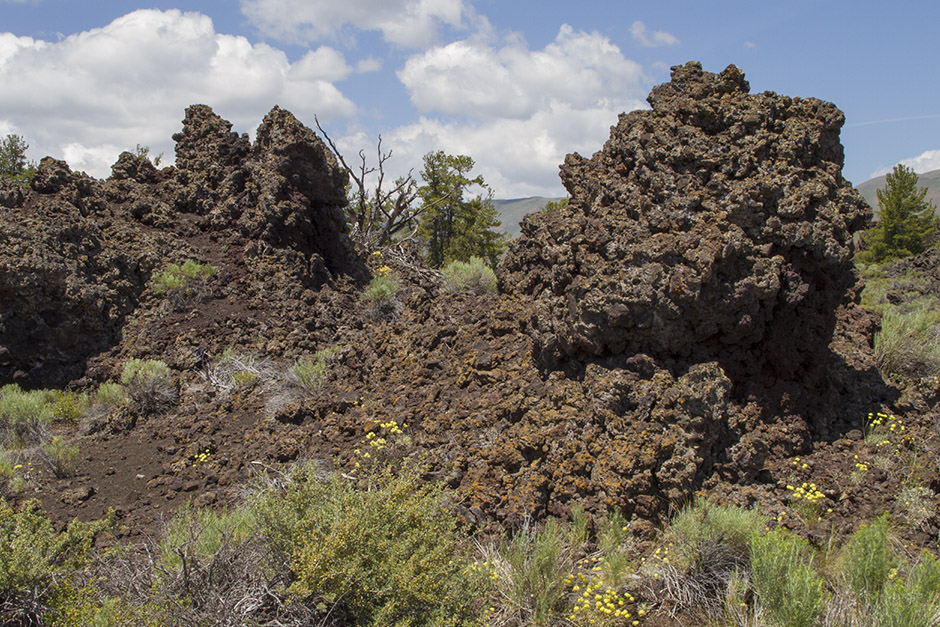
Tilted chunks of lava
There are various types of lava flows found in Craters of the Moon. The most common lava flows in the Monument are called Pahoehoe (pronounced pah-hoy-hoy), a Hawaiian word meaning ropey. As rivers of molten rock, they harden quickly to a relatively smooth surface, often hummocky or flat. Some formations resemble coiled rope. Pahoehoe lava flows are very hot, thin and runny. The low silica content causes it to cool quickly to a smooth ropey texture. Silica, or silicon dioxide, is the most abundant rock-forming compound on Earth and is the predominant molecular constituent of volcanic rocks and magmas. The low silica content causes the lava to be fairly fluid allowing it to flow easier. High silica content causes a flow to travel more slowly.
Other flows are called Aa, (pronounced ah-ah), a Hawaiian word meaning rough or blocky. These are irregular, jagged flows and occur when a Pahoehoe cools and thickens and turns into Aa lava. The extremely abrasive surface makes it a challenge to cross Aa lava on foot. The sharp edges can destroy hiking boots. This difference in form reflects flow dynamics.
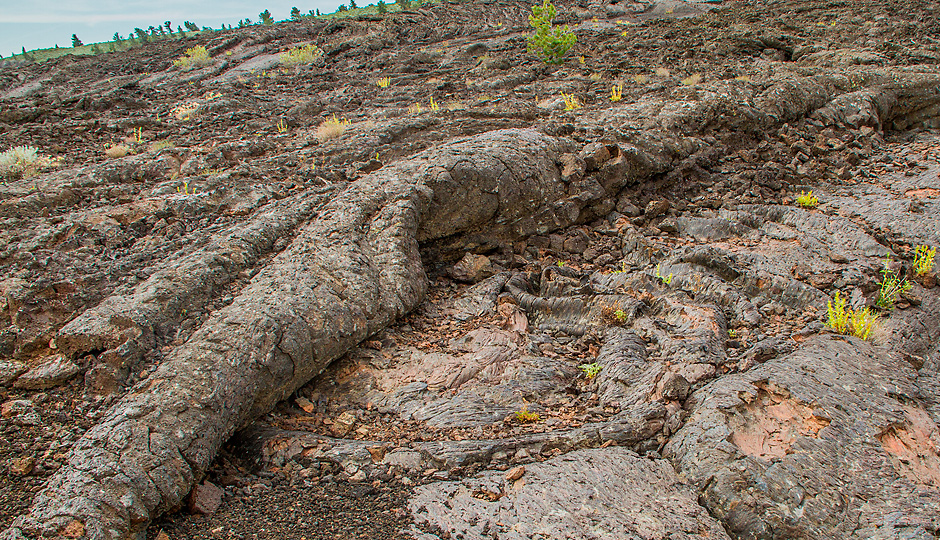
Sculpted flow
Cinder Cones are the simplest type of volcano. They are built from particles and globs of congealed lava ejected from a single vent. As the gas-charged lava is blown violently into the air, it breaks into small fragments that solidify and fall as cinders around the vent to form a circular or oval cone. These cone shaped hills are usually truncated, looking as though the tops have been sliced off. Cinder cones, hundreds of feet high, can form in a few days. Big Cinder Butte, a cinder cone at 700 feet high, is the tallest one in the Monument and is one of the world's largest, purely basaltic cinder cones.
A spatter cone is created when most of its lava gas has dissipated and the lava becomes less frothy and more tacky. Then it's tossed out of the vent as globs of lava paste called spatter. The globs pile up on each other, forming a cone-shaped structure around the vent. They often have flattened summits and are smaller than cinder cones. The spatter cone area of the Monument contains one of the most perfect spatter cone chains in the world. These cones are usually less than a 100 feet high and just a few hundred feet in diameter. When a solid crust forms over lava streams, and the lava flow changes course, lava tubes are created to leave a hollow lava tube behind.
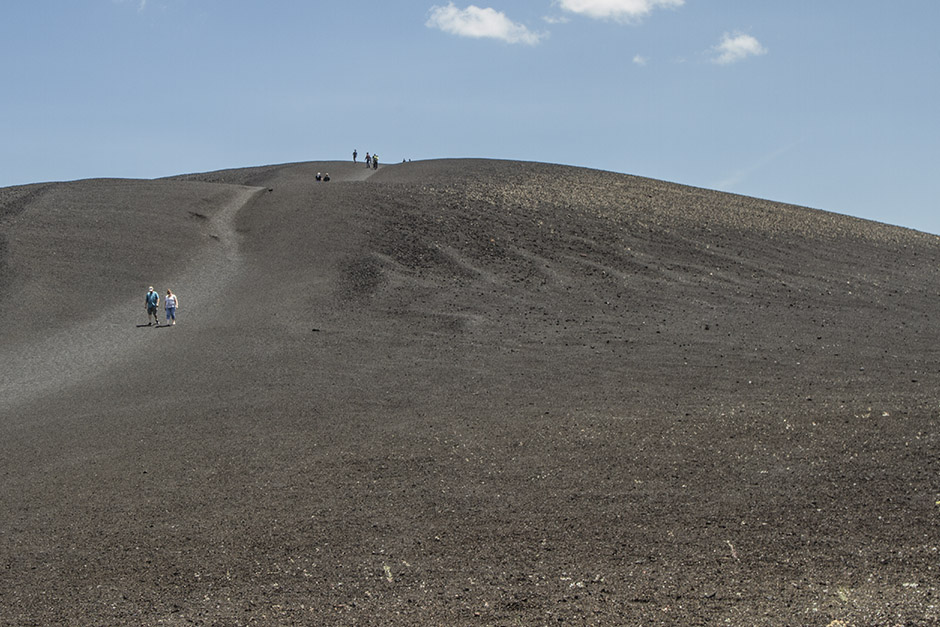
Huge cinder cone
History
American Indians did not inhabit the immense lava fields, however, The Northern Shoshone, a hunting, gathering culture, hunted several game species here such as bison, elk and black bears; species that are absent today.
Early pioneers searching for gold or farmlands bypassed the Craters inhospitable lava fields by a route known as Goodale's Cutoff. The route discovered in 1820, came into use in 1852 for emigrant wagons. To avoid Indian hostility and to avoid mountains to the north and lava fields to the south, Timothy Goodale guided a large emigrant party of Idaho pioneers through this route in 1862. Most water is inaccessible when it is soaked up like a giant sponge when it reaches the lava fields. However, as the pioneers by-passed the lava fields they found water at Lava Lake.
It wasn't until 1901 that geologists of the U.S. Geological Survey began exploration of the uninhabitable area. More detailed knowledge and discoveries that they and later explorers discovered eventually led to the proclamation of Craters of the Moon as a National Monument.
President Calvin Coolidge designated Craters of the Moon National Monument, approximately 83 square miles, located on the northern border of the Snake River Plain in south central Idaho, on May 2, 1924. In 2000, an additional 640 square miles of the surrounding Craters of the Moon and adjacent Wapi lava fields were added to the National Park System as Craters of the Moon National Preserve. This action ensured that the Great Rift, a 52-mile long volcanic fissure, and the massive flows that erupted and flowed from it would be protected as one landscape. The Monument and Preserve are now the size of Rhode Island.
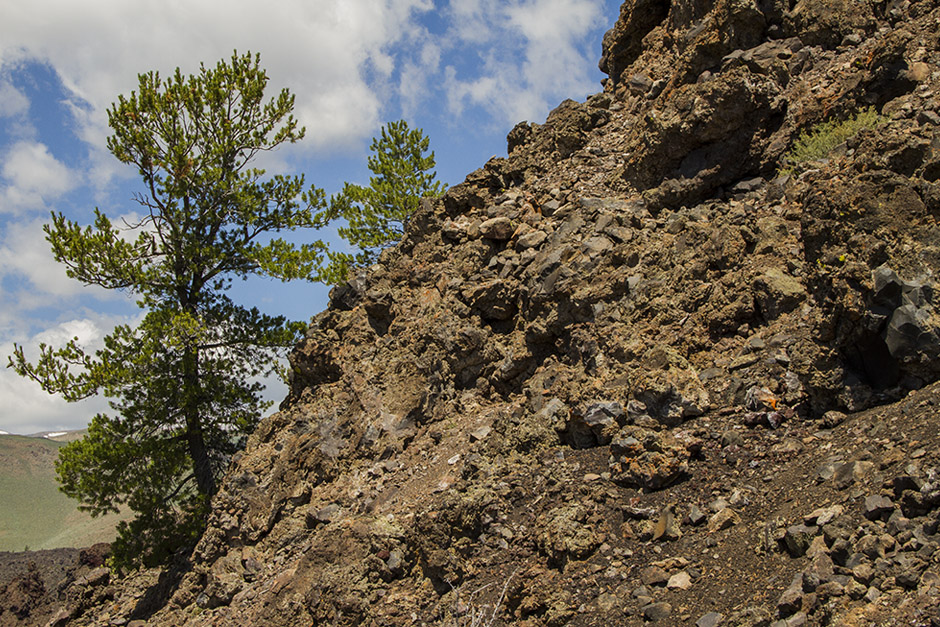
Persistence of Nature
Plant life
In this unforgiving lava environment most of the world's vegetation could not survive. Highly porous lava and cinders cannot retain water at its surface where plants and other organisms can make use of it. The meager rainfall that averages 15 to 20 inches a year quickly sinks through the top porous layer to layers too far down for plant roots to reach. Summer's persistent, hot dry winds rob moisture vital to vegetations existence. Since the last volcanic activity 2,000 years ago, soil has slowly gathered in crevices allowing plants to take root and survive in the megar shade and shelter they provide.
Limber pines, the pioneer trees of the Craters, were scattered among the lava islands. The pine, an evergreen, is so named because their branches bend under stress. It is a medium sized tree, averaging 20 inches in diameter and grows to an average height of 40 feet. Slow growing and long-lived, it often takes several hundred years to reach maturity. Mature trees often exceed 1000 years of age. The central trunk is usually distorted, many branched, and twisted. Limber pines reproduce entirely from seed. It's found throughout the Canyons. Pine "nuts" provides critical food for rodents and birds that cache the seeds for later use.
An amazing example of a plant's ability to adapt to a hostile dry environment is the dwarf buckwheat that grows on cinders. They are so evenly spaced that they appear to have been deliberately planted by humans. Their regular spacing is the result of a root system that exploits the available water from an area of ground surface much greater than the spread of their foliage. This results in dwarf buckwheat mature plants fending off competition by using the moisture that a competitive species would use. The result is a "garden' of evenly spaced plants.
Plants have developed three major strategies to combat the lack of water, lack of soil, hot dry winds and drought. Many plants take on modifications such as small leaves, succulence and hairiness. The tiny leaves of the antelope bitter-brush expose fewer surfaces to evaporative heat and wind. The hairy leaves of the scorpion weed reduce surface evaporation by inhibiting airflow and reflecting sunlight. Succulent plants such as cactus can store water in case of drought.

Mock Orange plant
Wildlife
In spite of the unforgiving environment fifty-eight species of mammals live at Craters of the Moon. Some animals, such as golden-mantled ground squirrels, chipmunks, yellow-bellied marmots, and mule deer, are common. Many of the Monument's animals are inactive during daylight hours and live underground or in the shade and shelter of lava crevasses. Smaller mammals can more easily adapt to the hot climate and scarce water at Craters of the Moon. They require less food and water, and they have an easier time finding shelter than larger mammals. There are twenty-one species of rodents including ten mice and seven squirrels.
American Pikas that inhabit Craters of the Moon are darker than pika from the mountains and find shelter in shady crevasses during the summers heat. The many caves at Craters provide year-round refuge for eleven species of bats. Many caves also contain the nests of bushy-tailed wood rats. Although these are rarely seen and secretive, they are a widespread resident of the lava flows.
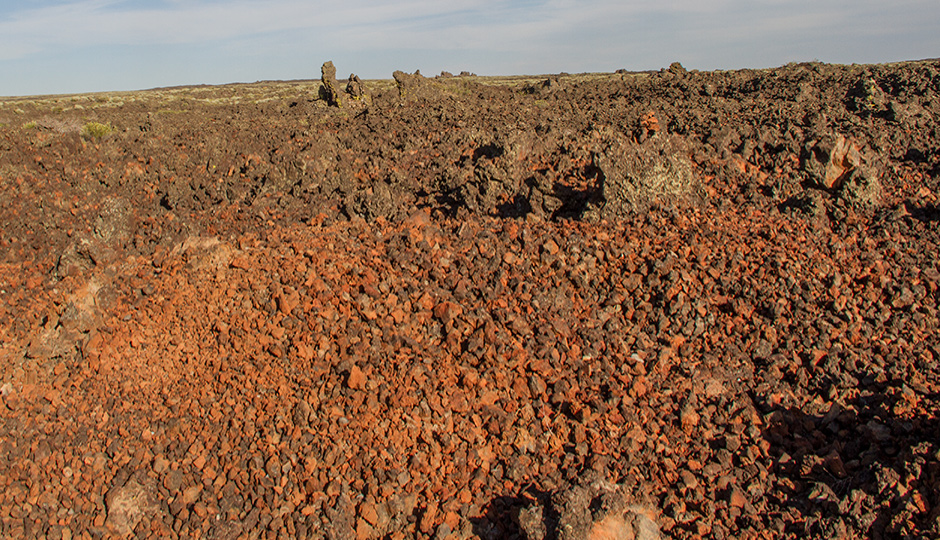
Some areas are like crushed stone
Larger mammals, like mule deer, antelope and elk, cover greater territory in order to find food and water. They migrate to nearby mountains during the summer to escape the Crater's heat and to find food. Mule deer migrate to mid elevations in the spring and to higher elevations in the late summer as vegetation dries out. America’s antelope, the pronghorn, migrates through the lava fields in the spring and fall and newborns are sometimes seen with their mothers in the spring.
The Future
Although the last eruptions occurred 2000 years ago, scientists believe that Craters of the Moon is not inactive but merely dormant. It is believed that eruptions will occur again within the next 1000 years.

Variety in the landscape
Helen Describes Her Visit to Craters of the Moon [Page One]
Back to [National Parks Index]
